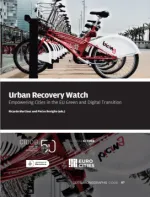Conclusion: is the EU recovery plan delivering on its promises? Key challenges and the way forward for public investments

Next Generation EU’s potential of around €750bn in firepower – possible thanks to Eurobonds – is a unique investment plan in the history of the EU to react to an unprecedented asymmetric shock. It will have implications far beyond economic recovery and has the potential to shape Europe’s development model for years to come. If successful, it will accelerate Europe’s just green and digital transformation and put Europe on the path to climate neutrality. For this to happen, the role of cities and their transformation are crucial.
At the same time, it represents a new way of promoting public investments at the EU level. The most optimistic in an initial phase asked themselves: can we consider Next Generation EU a real turning point compared to the paradigm of austerity at EU level, and can this be considered a model for the future to support public investments at local level for the challenges of transition and territorial cohesion?
Unfortunately, the evidence – including our Urban Recovery Watch – seems to suggest that this instrument is not solid enough to drive the required urban transformations for a just green and digital transformation and reverse the effects of austerity. While the EU recovery plan is a key tool, it was never intended to be the solution to years of underinvestment at local level. Long-term investments are still scarce and a recovery tool that promotes short-term investments to absorb a shock cannot be “resilient” and sustainable in the long term. As we argue, the lack of a long-term perspective to public investment – including the need for capacity to deliver investments – is contributing to some of the implementation challenges of the Recovery and Resilience Facility (RRF), the main delivery instrument of Next Generation EU.